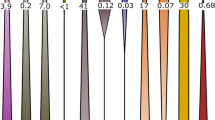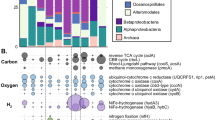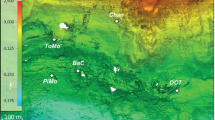Abstract
Fermentation-based metabolism is an important ecosystem function often associated with environments rich in organic carbon, such as wetlands, sewage sludge and the mammalian gut. The diversity of microorganisms and pathways involved in carbon and hydrogen cycling in sediments and aquifers and the impacts of these processes on other biogeochemical cycles remain poorly understood. Here we used metagenomics and proteomics to characterize microbial communities sampled from an aquifer adjacent to the Colorado River at Rifle, CO, USA, and document interlinked microbial roles in geochemical cycling. The organic carbon content in the aquifer was elevated via acetate amendment of the groundwater occurring over 2 successive years. Samples were collected at three time points, with the objective of extensive genome recovery to enable metabolic reconstruction of the community. Fermentative community members include organisms from a new phylum, Melainabacteria, most closely related to Cyanobacteria, phylogenetically novel members of the Chloroflexi and Bacteroidales, as well as candidate phyla genomes (OD1, BD1-5, SR1, WWE3, ACD58, TM6, PER and OP11). These organisms have the capacity to produce hydrogen, acetate, formate, ethanol, butyrate and lactate, activities supported by proteomic data. The diversity and expression of hydrogenases suggests the importance of hydrogen metabolism in the subsurface. Our proteogenomic data further indicate the consumption of fermentation intermediates by Proteobacteria can be coupled to nitrate, sulfate and iron reduction. Thus, fermentation carried out by previously unknown members of sediment microbial communities may be an important driver of nitrogen, hydrogen, sulfur, carbon and iron cycling.
Similar content being viewed by others
Log in or create a free account to read this content
Gain free access to this article, as well as selected content from this journal and more on nature.com
or
References
Aklujkar M, Young ND, Holmes D, Chavan M, Risso C, Kiss HE et al (2010). The genome of Geobacter bemidjiensis, exemplar for the subsurface clade of Geobacter species that predominate in Fe(III)-reducing subsurface environments. BMC Genomics 11: 490.
Allgaier M, Reddy A, Park JI, Ivanova N, D’haeseleer P, Lowry S et al (2010). Targeted discovery of glycoside hydrolases from a switchgrass-adapted compost community. PLoS One 5: e8812.
Averill BA . (1996). Dissimilatory nitrite and nitric oxide reductases. Chem Rev 96: 2951–2964.
Ballor NR, Leadbetter JR . (2011). Analysis of extensive [FeFe] hydrogenase gene diversity within the gut microbiota of insects representing five families of Dictyoptera. Microbial Ecol 63: 586–595.
Beller HR, Chain PS, Letain TE, Chakicherla A, Larimer FW, Richardson PM et al (2006). The genome sequence of the obligately chemolithoautotrophic, facultatively anaerobic bacterium Thiobacillus denitrificans. J Bacteriol 188: 1473–1488.
Berlemont R, Martiny AC . (2013). Phylogenetic distribution of potential cellulases in bacteria. Appl Environ Microbiol 79: 1545–1554.
Bianchi TS . (2011). The role of terrestrially derived organic carbon in the coastal ocean: a changing paradigm and the priming effect. Proc Natl Acad Sci 108: 19473–19481.
Brazelton WJ, Nelson B, Schrenk MO . (2012). Metagenomic evidence for H2 oxidation and H2 production by serpentinite-hosted subsurface microbial communities. Front Microbiol 2: 268.
Briée C, Moreira D, López-García P . (2007). Archaeal and bacterial community composition of sediment and plankton from a suboxic freshwater pond. Res Microbiol 158: 213–227.
Byrne-Bailey KG, Weber KA, Chair AH, Bose S, Knox T, Spanbauer TL et al (2010). Completed genome sequence of the anaerobic iron-oxidizing bacterium Acidovorax ebreus strain TPSY. J Bacteriol 192: 1475–1476.
Castelle CJ, Hug LA, Wrighton KC, Thomas BC, Williams KH, Wu D et al (2013). Extraordinary phylogenetic diversity and metabolic versatility in aquifer sediment. Nat Commun 4: 2120.
Coates JD, Chakraborty R, Lack JG, O'Connor SM, Cole KA, Bender KS et al (2001). Anaerobic benzene oxidation coupled to nitrate reduction in pure culture by two strains of Dechloromonas. Nature 411: 1039–1043.
Dick GJ, Andersson AF, Baker BJ, Simmons SL, Thomas BC, Yelton AP et al (2009). Community-wide analysis of microbial genome sequence signatures. Genome Biol 10: R85.
Di Rienzi SC, Sharon I, Wrighton KC, Koren O, Hug LA, Thomas BC et al. The human gut and groundwater harbor non-photosynthetic bacteria belonging to a new candidate phylum sibling to Cyanobacteria. eLife, (2013) 2: e01102.
Druhan JL, Steefel CI, Molins S, Williams KH, Conrad ME, DePaolo DJ . (2012). Timing the onset of sulfate reduction over multiple subsurface acetate amendments by measurement and modeling of sulfur isotope fractionation. Environ Sci Technol 46: 8895–8902.
Engelhardt T, Sahlberg M, Cypionka H, Engelen B . (2011). Induction of prophages from deep-subseafloor bacteria. Environ Microbiol 3: 459–465.
Finster K, Liesack W, Thamdrup B . (1998). Elemental sulfur and thiosulfate disproportionation by Desulfocapsa sulfoexigens sp. nov., a new anaerobic bacterium isolated from marine surface sediment. Appl Environ Microbiol 64: 119–125.
Friedrich CG, Rother D, Bardischewksy F, Quentmeier A, Fischer J . (2001). Oxidation of reduced inorganic sulfur compounds by bacteria: emergence of a common mechanism? Appl Environ Microbiol 67: 2873–2882.
Goris J, Konstantinidis KT, Klappenbach JA, Coenye T, Vandamme P, Tiedje JM . (2007). DNA-DNA hybridization values and their relationship to whole-genome sequence similarities. Int J Systemic Evolutionary Microbiol 57: 81–91.
Grant RF, Desai AR, Sulman BN . (2012). Modelling contrasting responses of wetland productivity to changes in water table depth. Biogeosciences Discussions 9: 5579–5623.
Green SJ, Prakash O, Gihring TM, Akob DM, Jasrotia P, Jardine PM et al (2010). Denitrifying Bacteria isolated from terrestrial subsurface sediments exposed to mixed-waste contamination. Appl Environ Microbiol 76: 3244–3254.
Handley KM, VerBerkmoes NC, Steefel CI, Williams KH, Sharon I, Miller CS et al (2013). Biostimulation induces syntrophic interactions that impact C, S and N cycling in a sediment microbial community. ISME J 7: 800–816.
Handley KM, Wrighton KC, Piceno YM, Andersen GL, DeSantis TZ, Williams KH et al (2012). High-density PhyloChip profiling of stimulated aquifer microbial communities reveals a complex response to acetate amendment. FEMS Microbiol Ecol 81: 188–204.
Herrmann G, Jayamani E, Mai G, Buckel W . (2008). Energy conservation via electron-transferring flavoprotein in anaerobic bacteria. J Bacteriol 190: 784–791.
Hug LA, Castelle CJ, Wrighton KC, Thomas BC, Sharon I, Frischkorn KR et al (2013). Community genomic analyses constrain the distribution of metabolic traits across the Chloroflexi phylum and indicate roles in sediment carbon cycling. Microbiome 1: 22.
Kantor RS, Wrighton KC, Handley KM, Sharon I, Hug LA, Castelle CJ et al (2013). Small genomes and sparse metabolisms of sediment-associated bacteria from four candidate phyla. mBio 4: e00708–e00713.
Knoblauch C, Sahm K, Jørgensen BB . (1999). Psychrophilic sulfate-reducing bacteria isolated from permanently cold arctic marine sediments: description of Desulfofrigus oceanense gen. nov., sp. nov., Desulfofrigus fragile sp. nov., Desulfofaba gelida gen. nov., sp. nov., Desulfotalea psychrophila gen. nov., sp. nov. and Desulfotalea arctica sp. nov. Int J Syst Bacteriol 49: 1631–1643.
Kuzyakov Y, Friedel JK, Stahr K . (2000). Review of mechanisms and quantification of priming effects. Soil Biol Biochem 32: 1485–1498.
Miletto M, Williams KH, N'Guessan AL, Lovley DR . (2011). Molecular analysis of the metabolic rates of discrete subsurface populations of sulfate reducers. Appl Environ Microbiol 77: 6502–6509.
Pereira IA, LeGall J, Xavier AV, Teixeira M . (2000). Characterization of a heme c nitrite reductase from a non-ammonifying microorganism, Desulfovibrio vulgaris Hildenborough. Biochimica et Biophysica Acta 1481: 119–130.
Peura S, Eiler A, Bertilsson S, Tiirola M, Jones RI . (2012). Distinct and diverse anaerobic bacterial communities in boreal lakes dominated by candidate division OD1. ISME J, 1–13.
Raes J, Korbel JO, Lercher MJ, Mering VC, Bork P . (2007). Prediction of effective genome size in metagenomic samples. Genome Biol 8: 1.
Rabus R, Ruepp A, Frickey T, Rattei T, Fartmann B, Stark M et al (2004). The genome of Desulfotalea psychrophila, a sulfate-reducing bacterium from permanently cold Arctic sediments. Environm Microbiol 6: 887–902.
Riley WJ, Subin ZM, Lawrence DM, Swenson SC, Torn MS, Meng L et al (2011). Barriers to predicting changes in global terrestrial methane fluxes: analyses using CLM4Me, a methane biogeochemistry model integrated in CESM. Biogeosciences 8: 1925–1953.
Rivett MO, Buss SR, Morgan P, Smith JWN, Bemment CD . (2008). Nitrate attenuation in groundwater: a review of biogeochemical controlling processes. Water Res 42: 4215–4232.
Roychoudhury AN, Merrett GL . (2006). Redox pathways in a petroleum contaminated shallow sandy aquifer: Iron and sulfate reductions. Sci Total Environ 366: 262–274.
Schmidt O, Drake HL, Horn MA . (2010). Hitherto unknown [Fe-Fe]-hydrogenase gene diversity in anaerobes and anoxic enrichments from a moderately acidic fen. Appl Environ Microbiol 76: 2027–2031.
Schut GJ, Adams MWW . (2009). The iron-hydrogenase of Thermotoga maritima utilizes ferredoxin and NADH synergistically: a new perspective on anaerobic hydrogen production. J Bacteriol 191: 4451–4457.
Sharma S, Cavallaro G, Rosato A . (2010). A systematic investigation of multiheme c-type cytochromes in prokaryotes. J Biol Inorganic Chem 15: 559–571.
Sharon I, Morowitz MJ, Thomas BC, Costello EK, Relman DA, Banfield JF . (2013). Time series community genomics analysis reveals rapid shifts in bacterial species, strains, and phage during infant gut colonization. Genome Res 23: 111–120.
Shrout JD, Scheetz TE, Casavant TL, Parkin GF . (2005). Isolation and characterization of autotrophic, hydrogen-utilizing, perchlorate-reducing bacteria. Appl Microbiol Biotechnol 67: 261–268.
Sieber JR, McInerney MJ, Gunsalus RP . (2012). Genomic insights into syntrophy: the paradigm for anaerobic metabolic cooperation. Annu Rev Microbiol 66: 429–452.
Thamdrup B, Finster K, Wurgler Hansen J, Bak F . (1993). Bacterial disproportionation of elemental sulfur coupled to chemical reduction of iron or manganese. Appl Environ Microbiol 59: 101–108.
Tveit A, Schwacke R, Svenning MM, Urich T . (2013). Organic carbon transformation in high-Arctic peat soils: key functions and microorganisms. ISME J 7: 299–311.
Vignais PM, Billoud B . (2007). Occurrence, classification, and biological function of hydrogenases: an overview. Chem Rev 107: 4206–4272.
Weber KA, Achenbach LA, Coates JD . (2006). Microorganisms pumping iron: anaerobic microbial iron oxidation and reduction. Nat Rev Microbiol 4: 752–764.
Whitman WB, Coleman DC, Wiebe WJ . (1998). Prokaryotes: the unseen majority. Proc Natl Acad Sci USA 95: 6578–6583.
Wilkins MJ, Callister SJ, Miletto M, Williams KH, Nicora CD, Lovley DR et al (2010). Development of a biomarker for Geobacter activity and strain composition; Proteogenomic analysis of the citrate synthase protein during bioremediation of U(VI). Microbial Biotechnol 4: 55–63.
Wilkins MJ, Wrighton KC, Nicora CD, Williams KH, McCue LA, Handley KM et al (2013). Fluctuations in species-level protein expression occur during element and nutrient cycling in the subsurface. PLoS One 8: e57819.
Williams KH, Long PE, Davis JA, Wilkins MJ, N'Guessan AL, Steefel CI et al (2011). Acetate availability and its influence on sustainable bioremediation of uranium-contaminated groundwater. Geomicrobiol J 28: 519–539.
Wrighton KC, Thomas BC, Sharon I, Miller CS, Castelle CJ, VerBerkmoes NC et al (2012). Fermentation, hydrogen, and sulfur metabolism in multiple uncultivated bacterial phyla. Science 337: 1661–1665.
Wrighton KC, Thrash JC, Melnyk RA, Bigi JP, Byrne-Bailey KG, Remis JP et al (2011). Evidence for direct electron transfer by a Gram-positive bacterium isolated from a microbial fuel cell. Appl Environ Microbiol 77: 7633–7639.
Yabusaki SB, Fang Y, Williams KH, Murray CJ, Ward AL, Dayvault RD et al (2011). Variably saturated flow and multicomponent biogeochemical reactive transport modeling of a uranium bioremediation field experiment. J Contaminant Hydrol 126: 271–290.
Yamada T, Sekiguchi Y, Hanada S, Imachi H, Ohashi A, Harada H et al (2006). Anaerolinea thermolimosa sp. nov, Levilinea saccharolytica gen. nov., sp. nov. and Leptolinea tardivitalis gen. nov., sp. nov., novel filamentous anaerobes, and description of the new classes Anaerolineae classis nov. and Caldilineae classis nov. in the bacterial phylum Chloroflexi. Int J Syst Evolutionary Microbiol 56: 1331–1340.
Zehr JP, Jenkins BD, Short SM, Steward GF . (2003). Nitrogenase gene diversity and microbial community structure: a cross-system comparison. Environ Microbiol 5: 539–554.
Zhuang K, Izallalen M, Mouser P, Richter H, Risso C, Mahadevan R et al (2010). Genome-scale dynamic modeling of the competition between Rhodoferax and Geobacter in anoxic subsurface environments. ISME J 5: 305–316.
Acknowledgements
This material is based upon work supported through the Integrated Field Research Challenge Site (IFRC) at Rifle, Colorado, the US Department of Energy (DOE), Office of Science, Office of Biological and Environmental Research funded the work under contract DE-AC02-05CH11231 (Lawrence Berkeley National Laboratory; operated by the University of California).
Author information
Authors and Affiliations
Corresponding author
Additional information
Supplementary Information accompanies this paper on The ISME Journal website
Supplementary information
Rights and permissions
About this article
Cite this article
Wrighton, K., Castelle, C., Wilkins, M. et al. Metabolic interdependencies between phylogenetically novel fermenters and respiratory organisms in an unconfined aquifer. ISME J 8, 1452–1463 (2014). https://doi.org/10.1038/ismej.2013.249
Received:
Revised:
Accepted:
Published:
Issue date:
DOI: https://doi.org/10.1038/ismej.2013.249
Keywords
This article is cited by
-
Microbial diversity in extreme environments
Nature Reviews Microbiology (2022)
-
Metagenomic and metatranscriptomic insights into sulfate-reducing bacteria in a revegetated acidic mine wasteland
npj Biofilms and Microbiomes (2022)
-
A human respiratory tract-associated bacterium with an extremely small genome
Communications Biology (2021)
-
High biodiversity in a benzene-degrading nitrate-reducing culture is sustained by a few primary consumers
Communications Biology (2021)
-
Evaluating sedimentary DNA for tracing changes in cyanobacteria dynamics from sediments spanning the last 350 years of Lake Tiefer See, NE Germany
Journal of Paleolimnology (2021)



